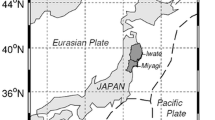Abstract
The fundamental mode Love and Rayleigh waves generated by earthquakes occurring in Kashmir, Nepal Himalaya, northeast India and Burma and recorded at Hyderabad, New Delhi and Kodaikanal seismic stations are analysed. Love and Rayleigh wave attenuation coefficients are obtained at time periods of 15–100 seconds, using the spectral amplitude of these waves for 23 different paths along northern (across Burma to New Delhi) and central (across Kashmir, Nepal Himalaya and northeast India to Hyderabad and Kodaikanal) India. Love wave attenuation coefficients are found to vary from 0.0003 to 0.0022 km−1 for northern India and 0.00003 km−1 to 0.00016 km−1 for central India. Similarly, Rayleigh wave attenuation coefficients vary from 0.0002 km−1 to 0.0016 km−1 for northern India and 0.00001 km−1 to 0.0009 km−1 for central India. Backus and Gilbert inversion theory is applied to these surface wave attenuation data to obtainQ β −1 models for the crust and uppermost mantle beneath northern and central India. Inversion of Love and Rayleigh wave attenuation data shows a highly attenuating zone centred at a depth of 20–80 km with lowQ for northern India. Similarly, inversion of Love and Rayleigh wave attenuation data shows a high attenuation zone below a depth of 100 km. The inferred lowQ value at mid-crustal depth (high attenuating zone) in the model for northern India can be by underthrusting of the Indian plate beneath the Eurasian plate which has caused a low velocity zone at this shallow depth. The gradual increase ofQ β −1 from shallow to deeper depth shows that the lithosphere-asthenosphere boundary is not sharply defined beneath central India, but rather it represents a gradual transformation, which starts beneath the uppermost mantle. The lithospheric thickness is 100 km beneath central India and below that the asthenosphere shows higher attenuation, a factor of about two greater than that in the lithosphere. The very lowQ can be explained by changes in the chemical constitution taking place in the uppermost mantle.
Similar content being viewed by others
References
Anderson, D. L., andArchambeau, C. B. (1964),The Anelasticity of the Earth, J. Geophys. Res.59, 2071–2084.
Anderson, D. L., Ben-Menahem, A., andArchambeau, C. B. (1965),Attenuation of Seismic Energy in the Upper Mantle, J. Geophys. Res.70, 1441–1448.
Banghar, A. R. (1972),Focal Mechanisms of Indian Earthquakes, Bull. Seismol. Soc. Am.62, 603–608.
Backus, G., andGilbert, F. (1970),Uniqueness in the Inversion of Gross Earth Data, Phil. Trans. R. Soc. LondonA266, 123–192.
Ben-Menahem, A., Jarosch, H., andRosenman, M. (1968),Large Scale Processing of Seismic Data in Search of Regional and Global Stress Patterns, Bull. Seismol. Soc. Am.58, 1899–1932.
Brewer, J. (1981),Thermal Effects of Thrust Faulting, Earth Planet. Sc. Lett.56, 233–244.
Burton, P. W. (1974),Estimation of Q −1 from Seismic Rayleigh Waves, Geophys. J. R. astr. Soc.36, 167–189.
Chandra, U. (1977),Earthquakes of Peninsular India—A Seismotectonic Study, Bull. Seismol. Soc. Am.67, 1387–1413.
Cheng, C. C., andMitchell, B. J. (1981),Crustal Q Structure in the United States from Multimode Surface Waves, Bull. Seismol. Soc. Am.71, 161–181.
Harkrider, D. G. (1968),The Perturbation of Love Wave Spectra, Bull. Seismol. Soc. Am.58, 861–880.
Herrmann, R. B., andMitchell, B. J. (1975),Statistical Analysis and Interpretation of Surface Wave Anelastic Attenuation Data for the Stable Interior of North America, Bull. Seismol. Soc. Am.65, 1115–1128.
Hwang, H. J., andMitchell, B. J. (1987),Shear Velocities, Q and the Frequency Dependence of Q in Stable and Tectonically Active Regions from Surface Wave Observations, Geophys. J. R. astr. Soc.90, 575–613.
Lee, W. B., andSolomon, S. C. (1975),Inverse Schemes for Surface Wave Attenuation and Q in the Crust and the Mantle, Geophys. J. R. astr. Soc.43, 47–71.
Mitchell, B. J. (1973),Surface Wave Attenuation and Crustal Anelasticity in Central N. America, Bull. Seismol. Am.63, 1057–1071.
Mitchell, B. J. (1975),Regional Rayleigh Wave Attenuation in North America, J. Geophys. Res.80, 4904–4916.
Patton, H. J., andTaylor, S. B. (1984),Q Structure of the Basin and Range from Surface Waves, J. Geophys. Res.89, 6929–6940.
Singh, D. D. (1982),Anelasticity of the Crust and Upper Mantle beneath the Eurasian Continent and Nearby Regions Free from the Inversion of Love and Rayleigh Wave Attenuation Data, Geophys. J. R. astr. Soc.71, 761–774.
Singh, D. D. (1987a),Crust and Upper Mantle Velocity Structure Beneath North and Central India from the Phase and Group Velocity of Rayleigh and Love Waves, Tectonophysics139, 187–203.
Singh, D. D. (1987b),Strain Rate and Earthquakes in the Himalayan and Nearby Regions, J. Phys. Earth35, 143–157.
Singh, D. D. (1988),Strain Deformation in the Northern Indian Ocean, Marine Geology79, 105–118.
Singh, D. D. (1990),Q-structure Beneath the North and Central Indian Ocean from the Inversion of Observed Love and Rayleigh Wave Attenuation Data, Phys. Earth Planet. Inter.59, 243–258.
Singh, D. D., andGupta, H. K. (1979),Source Mechanism and Surface Wave Attenuation Studies for Tibet Earthquake of July 14, 1973, Bull. Seismol. Soc. Am.68, 737–750.
Singh, D. D., andGupta, H. K. (1982),Q-structure Beneath the Tibetan Plateau from the Inversion of Love and Rayleigh Wave Attenuation Data, Phys. Earth Planet. Inter.29, 183–194.
Author information
Authors and Affiliations
Rights and permissions
About this article
Cite this article
Singh, D.D. Anelasticity of the crust and upper mantle beneath north and central India from the inversion of observed Love and Rayleigh wave attenuation data. PAGEOPH 135, 545–558 (1991). https://doi.org/10.1007/BF01772405
Received:
Revised:
Accepted:
Issue Date:
DOI: https://doi.org/10.1007/BF01772405




